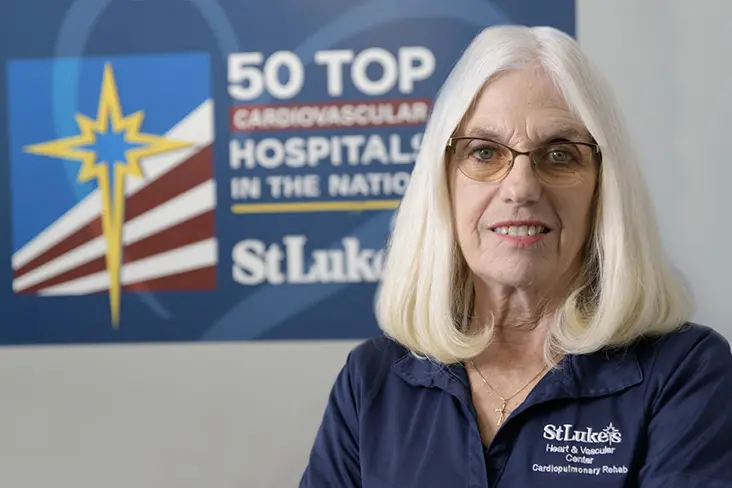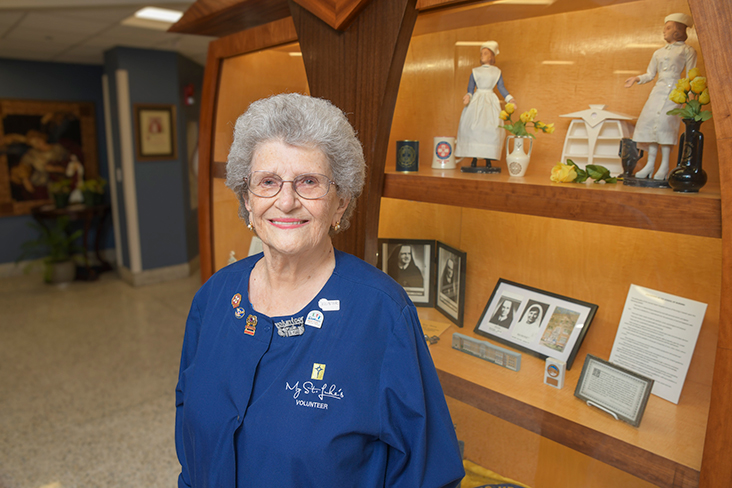Half-Century of Service and Still Counting

In her 52 years at St. Luke’s, Doreen Brueningsen has witnessed and lived through countless changes there. Thanks to her vivid memory, she can recount many of them and describe the impact they’ve had on the network, and on herself, as it grew to serve the local community and beyond.
“I’ve been working at St. Luke’s since the late ‘60s when St. Luke’s was only one hospital,” she says. “Today we have 14 and counting.”
Only about 200 people worked in the hospital at that time, recalls the 73-year-old Bethlehem resident who still works there part-time. “Everyone knew everyone else-- It was like a family.”
She started at St. Luke’s as a typist in Radiology in 1967, where she worked for 1.5 years before transferring to biomedical engineering. She can list the names of all of her bosses in that department to this day: Donald Heckert, Ken Jones, Bob Carl, Geoffrey Vokes, Chris Nowak, Bill Moyer, Don Seiple, John Mickley and Ken Schwarz.
“Bill Moyer and Don Seiple have gone on to become president of St. Luke’s campuses. St. Luke’s likes promoting from within.”
People came from near and far to work at the hospital. “Employees who lived up north in the coal regions often slept in dorm rooms in the Victoria White building during the week, then went home on weekends.” Victoria White has since been demolished.
You wouldn’t likely recognize the landscape of the hospital campus in Fountain Hill if you time-traveled back to those early days, says Brueningsen. It was rolling hills and only a handful of hospital buildings.
“There was no Pricilla Payne Hurd building, no Doctor’s Pavilion or parking garage back in the early days,” she remembers. Gradually older buildings were torn down to make room for more modern construction.
North Wing 4 was a floor of special, private patient rooms that patients—many from Bethlehem Steel-- could pay extra out-of-pocket to stay in. It had a solarium with rattan furniture and a beautiful view of Hotel Bethlehem on Main Street in downtown Bethlehem.
Like many employees there, Brueningsen also had cherished personal memories of the hospital.
“My daughter was born at St. Luke’s in 1969,” she explains. “I stayed with St. Luke’s because the hours were convenient for me to pick up my daughter after school.”
There were only a few medical specialties in the early days, and “Many patients, like my husband, who had heart problems, needed to go to New York or Philadelphia for advanced medical care.”
St. Luke’s gradually added clinical specialty programs and facilities so patients could receive care close to their homes.
“Everyone was excited when St. Luke’s first cardiologist, Dr. Sam Giamber, arrived here in the late 70’s,” says Brueningsen. “Now we have so many medical services and facilities here.”
In the 1970s, some resident doctors-in-training had long hair and looked like hippies, she remembers. “This bothered some of the older doctors, who wore suits and carried black bags (that’s how you could tell they were doctors).”
There weren’t pagers or cell phones, which came much later. “Doctors checked in with the switchboard when they were leaving for the night or coming in the morning,” Brueningsen recalls.
And “wellness” wasn’t yet a common concept in healthcare. Its purpose was to heal the ill and injured not really keep people from getting sick or hurt.
“It seemed like everyone smoked, in the hallways, cafeteria and in patient rooms,” she says. “Then smoking became limited to a room in the cafeteria before it was forbidden altogether in the 1980s.”
There was a ‘secret’ committee that enforced a dress code for women employees, mostly nurses: no open-toed shoes, short dresses or too much makeup.
Richard Suck was the administrator of the hospital in the 70s, and Richard Anderson replaced him, she remembers. “Mr. Anderson looked so young, but we are about the same age. He has done a good job as our current president.”
She remembers how people reacted when computers were introduced.
“People were upset, and some excited, with this new technology. I was nervous, but I learned to use them,” says Brueningsen.
But it wasn’t all work and no fun at the hospital, she reminisces.
“We had an orderly working here – in the mid-70s— who used to be an extra in Broadway shows. He coordinated a large talent show which featured our department heads and employees showing their singing and dancing talents.”
“It was professionally done under his direction – It was really amazing what a job everyone did – they held it at the local junior-high school on Union Blvd.”
After more than a half-century of service to St. Luke’s, Brueningsen says she continues to enjoy working there and has no plans to retire until she has to.
“I will continue working here as long as I have my health,” she says, then pauses and adds with a chuckle, “In fact, I plan to work here until I fall over.”
Longest Serving Employee on Record at Miners Campus
On January 6, 2025, Betty Benulis, RN, will celebrate a half-century of employment at St. Luke’s Miners Campus, a milestone that no other employee of the Coaldale hospital is known to have reached.
Read storyVolunteer Turns 97 after 80 Years with Sacred Heart Hospital
When as a teenager Grace Carr set out from a small town in coal country to become a nurse at Sacred Heart Hospital in Allentown, World War II was still raging. The year was 1944, and she has been with Sacred Heart ever since.
Read story
